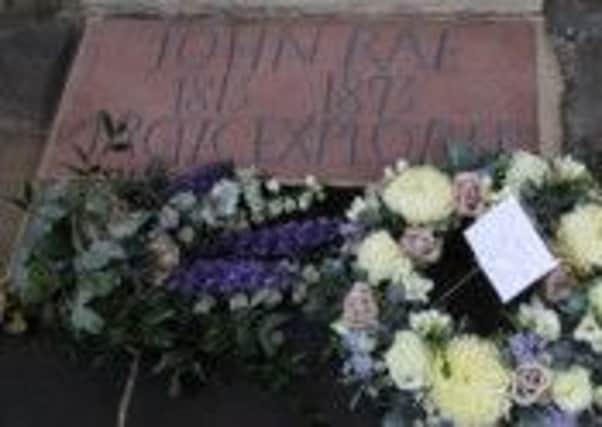Explorer John Rae gets Westminster Abbey plaque


The Victorian wrong was righted when the simple plaque for Orcadian surgeon turned explorer Dr John Rae was unveiled by the Dean of Westminster Abbey, the Very Rev Dr John Hall.
Dr Rae, a surgeon with the Hudson’s Bay Company, made a journey in the Arctic in 1854 to discover the fate of the 1845 Franklin Expedition and the awful tale of cannibalism he came back with shocked Victorian society.
Advertisement
Hide AdInuits told Rae they had found the mutilated bones of Sir John Franklin’s crew who had resorted to eating each other in an attempt to survive.


From that moment Dr Rae’s career was in ruins and writer Charles Dickens, enlisted by Franklin’s widow Lady Jane, wrote essays to discredit him, claiming that Inuit had killed the doomed crewmen.
Rae had returned with relics of the lost expedition and the news that the crew’s corpses had been mutilated.
Despite discovering the other great Arctic mystery – the final link in the Northwest Passage – Rae has for 160 years been denied recognition for telling the truth.
Rae lost his place in history as one of the most successful of Arctic explorers. He charted 1,765 miles of Arctic coastline.
A life-sized marble bust of Franklin with an epitaph by the then poet laureate, Alfred Lord Tennyson, was placed in Westminster Abbey in 1875, while Rae’s Portland stone memorial lies in St Magnus Cathedral in his native Orkney.
Advertisement
Hide AdNow, a simple plaque to Rae has been unveiled in the St John the Evangelist Chapel on Rae’s 201st birthday below Franklin’s memorial. It reads : ‘John Rae 1813 – 1893 Arctic Explorer’.
Orkney and Shetland MP Alistair Carmichael, who asked the Dean of Westminster, the Very Rev Dr John Hall, to allow the plaque, said: “At last Rae has got the proper recognition he deserves in the heart of the British establishment, not just in Orkney and Canada, where he is revered as a hero, up there with all the most famous explorers.”
Advertisement
Hide AdThe dean dedicated the memorial and told abbey guests this was a time of reconciliation. Rae and Franklin had explored together and he was persuaded this was the right thing to do.
During the ceremony Canadian author Ken McGoogan, whose bestselling book Fatal Passage championed Rae’s achievements, said: “John Rae became a target of a campaign which rendered him invisible. John Rae is al last being recognised here in Westminster Abbey. He has at last become visible. John Rae lives.”
A reading was made by the minister of St Magnus Cathedral in Kirkwall, while Fraser Macnaughton and Rae’s great great grand nieces Mary Davey and Jane Hamilton laid flowers.
Orkney fiddler Jennifer Wrigley played An Air for John Rae in the abbey, a piece she composed to play on Rae’s own fiddle last year on his 200th birthday. Simultaneously, her twin sister Hazel played the same tune in St Magnus Cathedral by Rae’s memorial following a ceremony at his graveside. A wreath was laid by Jean Craigie of the Hall of Clestrain where Rae was born.
Bushcraft expert Ray Mears, who presented a programme about John Rae in 2008, was among the abbey guests. He said: “It is fitting that this vilification of John Rae has been put right, not only for him but for all the Orcadians who played their part in the fur trade and an important role in history.”
Three weeks ago it was revealed that underwater archaeologists had discovered the wreck of one of Sir John Franklin’s ships, HMS Erebus and Terror, at King William’s Island, Nunavut, meaning that one of the world’s most enduring mysteries may now be solved.
Advertisement
Hide AdThe ships’ last port of call before crossing the Atlantic was Stromness where they took on water and gave the name to Franklin’s Well.
Funds for the abbey plaque were raised by The John Rae Society in Orkney.
SEE ALSO